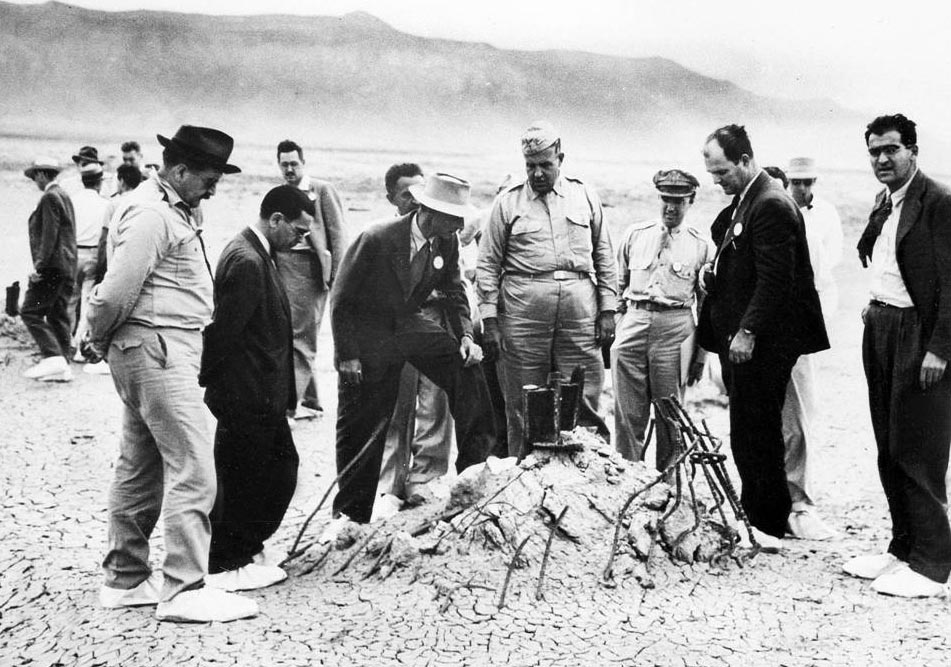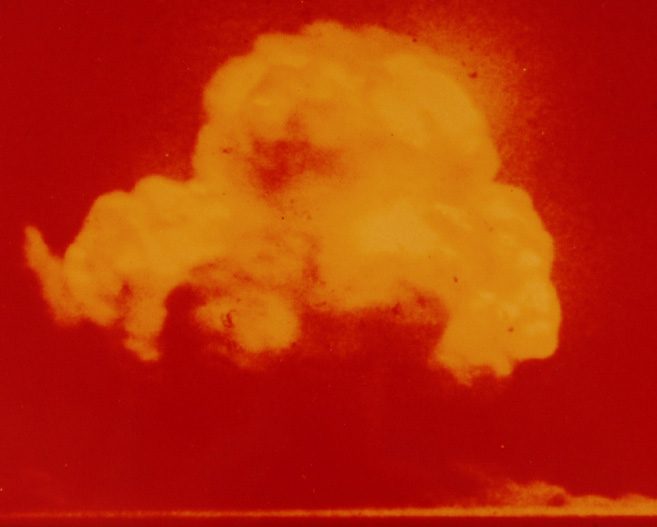On July 16, 1945, at 5:29:21 MT, Manhattan Project scientists conducted the world’s first atomic bomb test at the Trinity site near Alamogordo, New Mexico. The purpose of the test was to confirm that an implosion assembly method device with a plutonium core would set off a nuclear chain reaction. The bomb, called the “Gadget,” worked, setting off an explosion equal to about 18 kilotons of TNT. Around 260 scientists and soldiers witnessed the test, in addition to some scientists and their families who went up into the mountains to view the explosion.
“Voices of the Manhattan Project,” a partnership between the Atomic Heritage Foundation and the Los Alamos Historical Society to create a public archive of our oral history collections, has captured the memories of Trinity test witnesses. Here are some recollections. For more, click here, or check out the Atomic Heritage Foundation’s anthology, The Manhattan Project, which features more eyewitness accounts of the test and the Manhattan Project generally.
Lilli Hornig (chemist): “During the Trinity test—I knew it was coming up and in fact, two days before they’d had a malfunction down there, an early misfire on the X unit. And at two o’clock in the morning our group leader, Lewis Fussell, was knocking on my bedroom window saying, “You have to get up, we have some work to do.”
“But anyway, I had planned to drive up to Sandia Mountain, which had a nice road to the top and a clear view 110 miles down to the Trinity site. And so there we sat at ten thousand feet and we slept a little, we put sleeping bags on the ground. None of us slept very well, and so we got up about three o’clock, I guess, and started waiting for the shot, keeping our eyes glued on the site. And we waited and waited and at 4:30 the sun rose. And we were so crushed and disappointed and said, “Well, I guess it’s not going to go today,” and we had to go back up to the Hill [Los Alamos] and get to work. And so we packed up our sleeping bags and got in the car. It didn’t take long, I mean, it was quick decision, and I was sitting in the car reaching for my ignition key—and the thing bloomed in front of us. And of course we had neglected the fact that at ten thousand feet the sun rises earlier than it does at two thousand or three thousand down in the desert. So we blamed ourselves for not being good scientists there, but we did see it and it was just incredible.
 “Just a couple of nights ago I saw a film on PBS of the Super bomb tests and it reminded me very strongly, and of course the scale is far bigger, but the pictures are much like what I remember in my mind—these sort of boiling clouds and color—vivid colors like violet, purple, orange, yellow, red, just everything. It was fantastic. And we were all kind of shaken up. And we waited for the shock wave to come, which it did, I don’t know—fifteen, eleven, twelve, fifteen minutes later.
“Just a couple of nights ago I saw a film on PBS of the Super bomb tests and it reminded me very strongly, and of course the scale is far bigger, but the pictures are much like what I remember in my mind—these sort of boiling clouds and color—vivid colors like violet, purple, orange, yellow, red, just everything. It was fantastic. And we were all kind of shaken up. And we waited for the shock wave to come, which it did, I don’t know—fifteen, eleven, twelve, fifteen minutes later.
“And then we backed up and started down the mountain, and we stopped at a diner somewhere near Albuquerque for breakfast. And the guy behind the counter said, ‘You guys know anything about that explosion they had down at the proving grounds?’ We said, ‘What? No, we didn’t know about that.’”
Berlyn Brixner (Trinity test photographer): “I had arranged a very dense welding glass type of glasses in front of my eyes and I was looking directly at the Zero. I was one of the few people allowed to do that. It was perfectly safe through these welding glasses. But anyway I was looking right at it, just staring at where it was.
“Of course it was nighttime, I couldn’t see anything. But when the explosion went off, that welding glass seemed to just glow white, intense white like the sun. So it just blinded me, so I looked aside to the left, the Oscuras Mountains were at the left, and they were just lit up like daylight then. So I looked at that for a few seconds, and then I looked back through my welding glass and I saw that the terrific explosion had taken place. Just unbelievably large explosion. My camera was just sitting there, but soon the ball of fire was starting to rise and I thought, gee, I better get busy. So abruptly I raised it and photographed the ball of fire as it went up to the stratosphere. I kept photographing it for the next couple of minutes or so.
 “I was just so amazed that I was essentially dumbfounded by the explosion. We had had previously what was called a dry run and they piled up a hundred tons of TNT and exploded that to give us a kind of a test with all of our equipment and cameras. That was just nothing compared to this explosion. I knew immediately that the explosion had exceeded the greatest expectations and that essentially we had won the war because that bomb would soon be used on Japan. And it was. That was July 16, I believe, and the war was over only about three weeks later.”
“I was just so amazed that I was essentially dumbfounded by the explosion. We had had previously what was called a dry run and they piled up a hundred tons of TNT and exploded that to give us a kind of a test with all of our equipment and cameras. That was just nothing compared to this explosion. I knew immediately that the explosion had exceeded the greatest expectations and that essentially we had won the war because that bomb would soon be used on Japan. And it was. That was July 16, I believe, and the war was over only about three weeks later.”
Darragh Nagle (physicist): “We were involved in the preparations for the Trinity test, and our job was to collect soil samples from the crater as soon as possible after the explosion. And that involved fitting out a Sherman tank with lead shielding, and one of my jobs was to supervise the placement of the lead shielding. I was very interested in that because I knew I was going to have to ride in that tank and the lead shielding was what was going to keep my radioactive dose to something perhaps tolerable.
“Those that did ride into the crater, we took turns going in. Herbert Anderson went in first. Julius Tabin went in once, maybe twice. And I went in. Each of these trips was with one physicist running the sampling equipment. The only one we didn’t allow to go in was Fermi; we couldn’t risk him in such a place. We knew that the Sherman tanks had a habit of stalling, so we wondered what would happen if the tank stalled in the crater. And we knew the answer. I mean, that would have been the end—there’s no way we could have gotten out. Fortunately none of the runs ended that way.”
 Jack Aeby (physicist and photographer): “Somehow the theoretical division got wind of [my Trinity test photo] and they confiscated the photo for a time. And they actually did one of the first yield measurements by measuring the width of the fireball and estimated time of when that was made, and they could back calculate something resembling a good estimate of the yield. It turned out to be in agreement with the other estimates they had. I think they had to take an average of all the measurements they had because they were pretty crude in those days.
Jack Aeby (physicist and photographer): “Somehow the theoretical division got wind of [my Trinity test photo] and they confiscated the photo for a time. And they actually did one of the first yield measurements by measuring the width of the fireball and estimated time of when that was made, and they could back calculate something resembling a good estimate of the yield. It turned out to be in agreement with the other estimates they had. I think they had to take an average of all the measurements they had because they were pretty crude in those days.
“It wasn’t long after that General Groves, who wasn’t anywhere around, said he wanted that picture. Well, he got it [chuckle]. So it was published fairly widely once the secrecy was off and they could at last announce that they had then bombed Japan and it became public knowledge that such a weapon existed.
“So then they started publishing that picture as what happened at Trinity under the auspices of the US Army photo, so my credits didn’t stop or start ‘til later on. I was interviewed by a couple newspapers and they finally started giving me credit.”
Felix dePaula (soldier): “The night they detonated the bomb, they got us all out of the barracks and we all had to suit up. I can’t really recall how far I was from the bomb, but I believe it was something like five to seven miles. The detonating room was something like two miles from the bomb. We were all told to hold our backs to the detonation. Then after the explosion we were given these dark glasses, we could turn around and look at the effects after the bomb was detonated. We could feel the blast and the heat wave.
“Well you know, this still didn’t make a big impression on me because the only thing I’d ever seen in the way of explosives was firecrackers, you know. So we had a great big explosive. But this older man, name was Pop Borden, he came from upstate New York. This man had worked with dynamite in his days before he got into the service. I recall three, maybe four days after the detonation, that man still couldn’t eat; he still couldn’t get over the detonation. He’d go around and he’d say, ‘That’s the most terrible thing I’ve ever seen in my life.’
It still didn’t really make much of an impression on me until later on after we had seen pictures of what had happened after they had dropped the bombs on Hiroshima and Nagasaki. He could see the devastation that it could bring on. Because he had something to compare it to. I had nothing to compare it to.”





